Need an opportunity to become math proficient? Then, this article will help you to turn like that. As this page holds benefitted Big Ideas Math Algebra 1 Answers Chapter 11 Data Analysis and Displays Questions to solve and improve subject knowledge. Students who want to practice all topics from ch 11 Data Analysis and Displays can explore BIM algebra 1 ch 11 solution key pdf. Enhance your math skills with the help of 11.1 to 11.5 Exercises Questions, Practice Tests, Cumulative Assessment, Review Tests, Quiz, etc. involve in the BigIdeas Math Book Algebra 1 Chapter 11 Data Analysis and Displays Solution Key.
Big Ideas Math Algebra 1 Textbook Solutions for Chapter 11 Data Analysis and Displays
Make a great move at the time of your practice sessions or exam preparation by using the ultimate guide of Big Ideas Math Book Algebra 1 Answers Chapter 11 Data Analysis and Displays. This guide can help each and every learner by providing a deep level & step by step explanation about the concepts of Algebra 1 Ch 11. You can also make use of this BIM Algebra 1 Chapter 11 Data Analysis and Displays as quick revision material during exams.
These solutions are prepared by the subject experts as per the Common Core Curriculum. Click on the direct links available here and start practicing the respective Big Ideas Math Algebra 1 Textbook Answers of Chapter 11 concepts for better knowledge and performance in the annual exams.
- Data Analysis and Displays Maintaining Mathematical Proficiency – Page 583
- Data Analysis and Displays Mathematical Practices – Page 584
- Lesson 11.1 Measures of Center and Variation – Page(586-592)
- Measures of Center and Variation 11.1 Exercises – Page(590-592)
- Lesson 11.2 Box-and-Whisker Plots – Page(594-598)
- Box-and-Whisker Plots 11.2 Exercises – Page(597-598)
- Lesson 11.3 Shapes of Distributions – Page(600-606)
- Shapes of Distributions 11.3 Exercises – Page(604-606)
- Data Analysis and Displays Study Skills: Studying for Finals – Page 607
- Data Analysis and Displays 11.1–11.3 Quiz – Page 608
- Lesson 11.4 Two-Way Tables – Page(610-616)
- Two-Way Tables 11.4 Exercises – Page(614-616)
- Lesson 11.5 Choosing a Data Display – Page(618-622)
- Choosing a Data Display 11.5 Exercises – Page(621-622)
- Data Analysis and Displays Performance Task: College Students Study Time – Page – 623
- Data Analysis and Displays Chapter Review – Page(624-626)
- Data Analysis and Displays Chapter Test – Page 627
- Data Analysis and Displays Cumulative Assessment – Page (628-630)
Data Analysis and Displays Maintaining Mathematical Proficiency
The table shows the results of a survey. Display the data in a histogram.
Question 1.
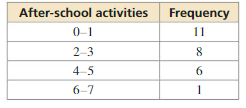
Answer:
Question 2.

Answer:
The table shows the results of a survey. Display the data in a circle graph.
Question 3.

Answer:
Question 4.
ABSTRACT REASONING
Twenty people respond “yes” or “no” to a survey question. Let a and b represent the frequencies of the responses. What must be true about the sum of a and b? What must be true about the sum when “maybe” is an option for the response?
Answer:
Data Analysis and Displays Mathematical Practices
Mathematically proficient students use diagrams and graphs to show relationships between data. They also analyze data to draw conclusions.
Using Data Displays

Monitoring Progress

Question 1.
The table shows the estimated populations of males and females by age in the United States in 2012. Use a spreadsheet, graphing calculator, or some other form of technology to make two different displays for the data.
Answer:
Question 2.
Explain why you chose each type of data display in Monitoring Progress Question 1. What conclusions can you draw from your data displays?
Answer:
Lesson 11.1 Measures of Center and Variation
Essential Question
How can you describe the variation of a data set?
EXPLORATION 1
Describing the Variation of Data
Work with a partner. The graphs show the weights of the players on a professional football team and a professional baseball team.

a. Describe the data in each graph in terms of how much the weights vary from the mean. Explain your reasoning.
b. Compare how much the weights of the players on the football team vary from the mean to how much the weights of the players on the baseball team vary from the mean.
c. Does there appear to be a correlation between the body weights and the positions of players in professional football? in professional baseball? Explain.
Answer:
EXPLORATION 2
Describing the Variation of Data
Work with a partner. The weights (in pounds) of the players on a professional basketball team by position are as follows.
Power forwards: 235, 255, 295, 245; small forwards: 235, 235;
centers: 255, 245, 325; point guards: 205, 185, 205; shooting guards: 205, 215, 185
Make a graph that represents the weights and positions of the players. Does there appear to be a correlation between the body weights and the positions of players in professional basketball? Explain your reasoning.
Answer:
Communicate Your Answer
Question 3.
How can you describe the variation of a data set?
Answer:
Monitoring Progress
Question 1.
WHAT IF?
The park hires another student at an hourly wage of $8.45. (a) How does this additional value affect the mean, median, and mode? Explain. (b) Which measure of center best represents the data? Explain.
Answer:
Question 2.
The table shows the annual salaries of the employees of an auto repair service. (a) Identify the outlier. How does the outlier affect the mean, median, and mode? (b) Describe one possible explanation for the outlier.
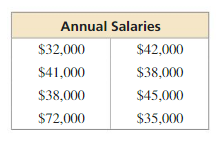
Answer:
Question 3.
After the first week, the 25-year-old is voted off Show A and the 48-year-old is voted off Show B. How does this affect the range of the ages of the remaining contestants on each show in Example 3? Explain.
Answer:
Question 4.
Find the standard deviation of the ages for Show B in Example 3. Interpret your result.
Answer:
Question 5.
Compare the standard deviations for Show A and Show B. What can you conclude?
Answer:
Question 6.
Find the mean, median, mode, range, and standard deviation of the altitudes of the airplanes when each altitude increases by \(\frac{1}{2}\) miles.
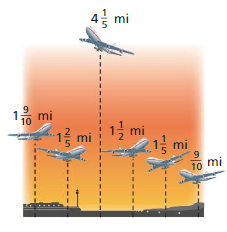
Answer:
Measures of Center and Variation 11.1 Exercises
Vocabulary and Core Concept Check
Question 1.
VOCABULARY
In a data set, what does a measure of center represent? What does a measure of variation describe?
Answer:

Question 2.
WRITING
Describe how removing an outlier from a data set affects the mean of the data set.
Answer:
Question 3.
OPEN-ENDED
Create a data set that has more than one mode.
Answer:

Question 4.
REASONING
What is an advantage of using the range to describe a data set? Why do you think the standard deviation is considered a more reliable measure of variation than the range?
Answer:
Monitoring Progress and Modeling with Mathematics
In Exercises 5–8, (a) Find the mean, median, and mode of the data set and (b) determine which measure of center best represents the data. Explain. (See Example 1.)
Question 5.
3, 5, 1, 5, 1, 1, 2, 3, 15
Answer:
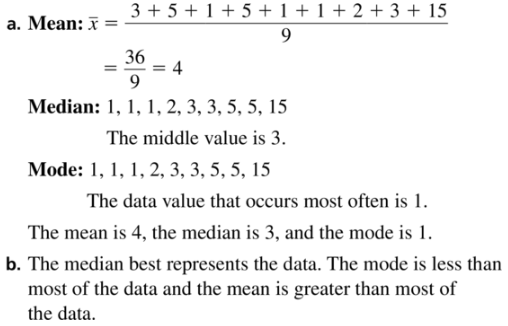
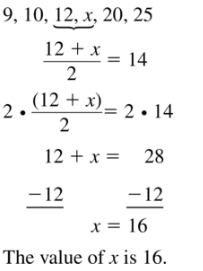
Question 6.
12, 9, 17, 15, 10
Answer:
Question 7.
13, 30, 16, 19, 20, 22, 25, 31
Answer:
Question 8.
14, 15, 3, 15, 14, 14, 18, 15, 8, 16
Answer:
Question 9.
ANALYZING DATA
The table shows the lengths of nine movies.
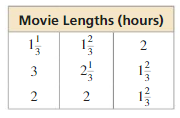
a. Find the mean, median, and mode of the lengths.
b. Which measure of center best represents the data? Explain.
Answer:
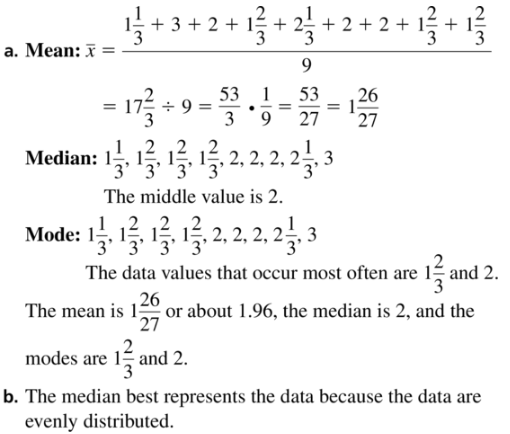
Question 10.
ANALYZING DATA
The table shows the daily changes in the value of a stock over 12 days.
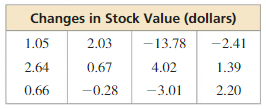
a. Find the mean, median, and mode of the changes in stock value.
b. Which measure of center best represents the data? Explain.
c. On the 13th day, the value of the stock increases by $4.28. How does this additional value affect the mean, median, and mode? Explain.
Answer:
In Exercises 11–14, find the value of x.
Question 11.
2, 8, 9, 7, 6, x; The mean is 6.
Answer:

Question 12.
12.5, -10, -7.5, x; The mean is 11.5.
Answer:
Question 13.
9, 10, 12, x, 20, 25; The median is 14.
Answer:
Question 14.
30, 45, x, 100; The median is 51.
Answer:
Question 15.
ANALYZING DATA
The table shows the masses of eight polar bears. (See Example 2.)

a. Identify the outlier. How does the outlier affect the mean, median, and mode?
b. Describe one possible explanation for the outlier.
Answer:
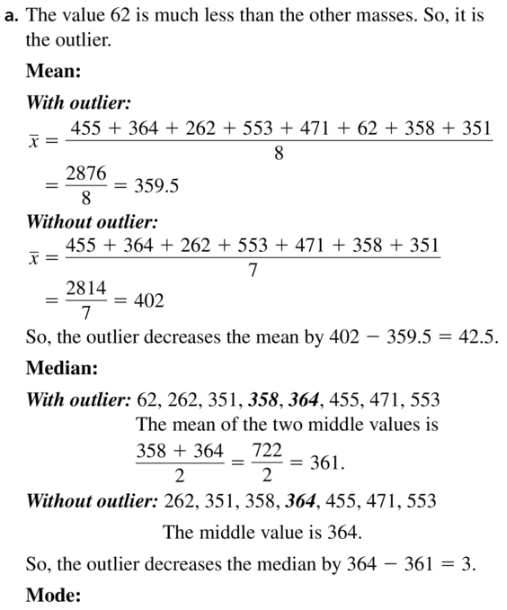

Question 16.
ANALYZING DATA
The sizes of emails (in kilobytes) in your inbox are 2, 3, 5, 2, 1, 46, 3, 7, 2, and 1.
a. Identify the outlier. How does the outlier affect the mean, median, and mode?
b. Describe one possible explanation for the outlier.
Answer:
Question 17.
ANALYZING DATA
The scores of two golfers are shown. Find the range of the scores for each golfer. Compare your results. (See Example 3.)
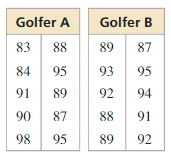
Answer:
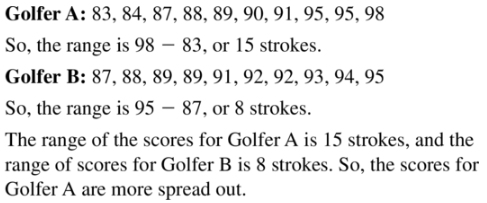
Question 18.
ANALYZING DATA
The graph shows a player’s monthly home run totals in two seasons. Find the range of the number of home runs for each season. Compare your results.
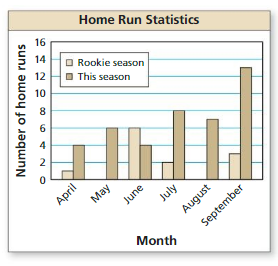
Answer:
In Exercises 19–22, find (a) the range and (b) the standard deviation of the data set.
Question 19.
40, 35, 45, 55, 60
Answer:
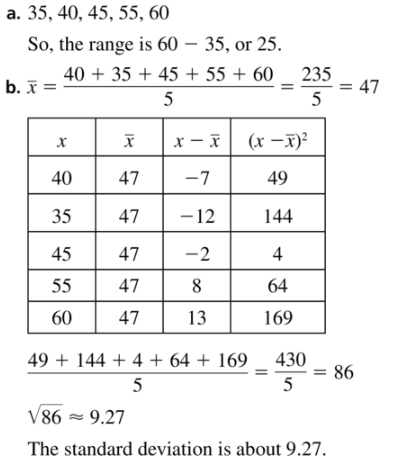
Question 20.
141, 116, 117, 135, 126, 121
Answer:
Question 21.
0.5, 2.0, 2.5, 1.5, 1.0, 1.5
Answer:
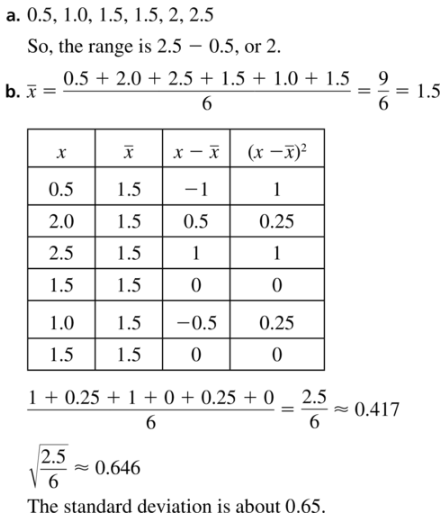
Question 22.
8.2, 10.1, 2.6, 4.8, 2.4, 5.6, 7.0, 3.3
Answer:
Question 23.
ANALYZING DATA
Consider the data in Exercise 17.
a. Find the standard deviation of the scores of Golfer A. Interpret your result.
b. Find the standard deviation of the scores of Golfer B. Interpret your result.
c. Compare the standard deviations for Golfer A and Golfer B. What can you conclude?
Answer:
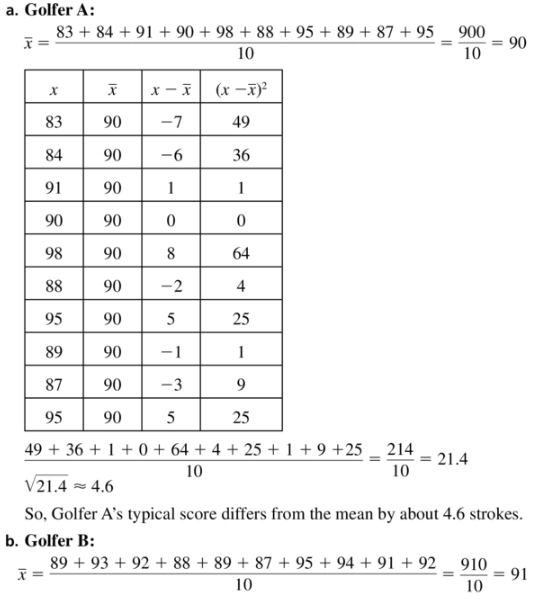
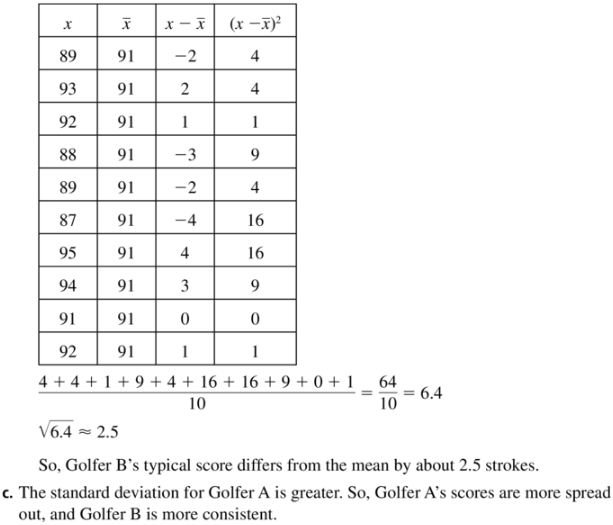
Question 24.
ANALYZING DATA
Consider the data in Exercise 18.
a. Find the standard deviation of the monthly home run totals in the player’s rookie season. Interpret your result.
b. Find the standard deviation of the monthly home run totals in this season. Interpret your result.
c. Compare the standard deviations for the rookie season and this season. What can you conclude?
Answer:
In Exercises 25 and 26, find the mean, median, and mode of the data set after the given transformation.
Question 25.
In Exercise 5, each data value increases by 4.
Answer:

Question 26.
In Exercise 6, each data value increases by 20%.
Answer:
Question 27.
TRANSFORMING DATA
Find the values of the measures shown when each value in the data set increases by 14.
Mean: 62
Median: 55
Mode: 49
Range: 46
Standard deviation: 15.5
Answer:
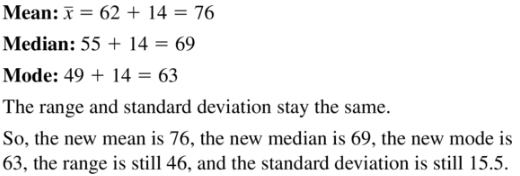
Question 28.
TRANSFORMING DATA
Find the values of the measures shown when each value in the data set is multiplied by 0.5.
Mean: 320
Median: 300
Mode: none
Range: 210
Standard deviation: 70.6
Answer:
Question 29.
ERROR ANALYSIS
Describe and correct the error in finding the median of the data set.

Answer:

Question 30.
ERROR ANALYSIS
Describe and correct the error in finding the range of the data set after the given transformation.
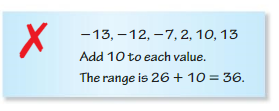
Answer:
Question 31.
PROBLEM SOLVING
In a bowling match, the team with the greater mean score wins. The scores of the members of two bowling teams are shown.
Team A: 172, 130, 173, 212
Team B: 136, 184, 168, 192

a. Which team wins the match? If the team with the greater median score wins, is the result the same? Explain.
b. Which team is more consistent? Explain.
c. In another match between the two teams, all the members of Team A increase their scores by 15 and all the members of Team B increase their scores by 12.5%. Which team wins this match? Explain.
Answer:

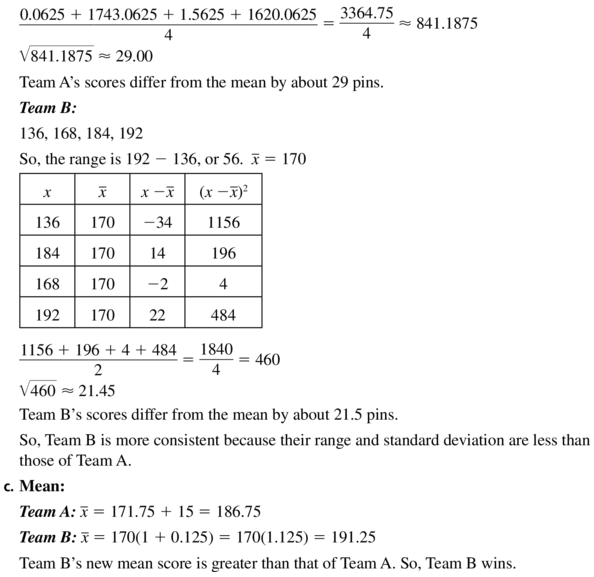
Question 32.
MAKING AN ARGUMENT
Your friend says that when two data sets have the same range, you can assume the data sets have the same standard deviation, because both range and standard deviation are measures of variation. Is your friend correct? Explain.
Answer:
Question 33.
ANALYZING DATA
The table shows the results of a survey that asked 12 students about their favorite meal. Which measure of center (mean, median, or mode) can be used to describe the data? Explain.

Answer:

Question 34.
HOW DO YOU SEE IT?
The dot plots show the ages of the members of three different adventure clubs. Without performing calculations, which data set has the greatest standard deviation? Which has the least standard deviation? Explain your reasoning.

Answer:
Question 35.
REASONING
A data set is described by the measures shown.
Mean: 27
Median: 32
Mode: 18
Range: 41
Standard deviation: 9
Find the mean, median, mode, range, and standard deviation of the data set when each data value is multiplied by 3 and then increased by 8.
Answer:
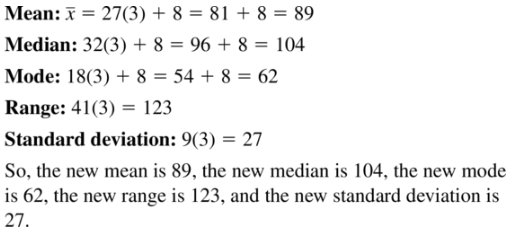
Question 36.
CRITICAL THINKING
Can the standard deviation of a data set be 0? Can it be negative? Explain.
Answer:
Question 37.
USING TOOLS
Measure the heights (in inches) of the students in your class.
a. Find the mean, median, mode, range, and standard deviation of the heights.
b. A new student who is 7 feet tall joins your class. How would you expect this student’s height to affect the measures in part (a)? Verify your answer.
Answer:

Question 38.
THOUGHT PROVOKING
To find the arithmetic mean of n numbers, divide the sum of the numbers by n. To find the geometric mean of n numbers a1, a2, a3, . . . , an, take the nth root of the product of the numbers.
geometric mean = \(\sqrt[n]{a_{1} \cdot a_{2} \cdot a_{3} \cdot \ldots \cdot a_{n}}\)
Compare the arithmetic mean to the geometric mean of n numbers.
Answer:
Question 39.
PROBLEM SOLVING
The circle graph shows the distribution of the ages of 200 students in a college Psychology I class.
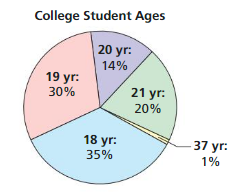
a. Find the mean, median, and mode of the students’ ages.
b. Identify the outliers. How do the outliers affect the mean, median, and mode?
c. Suppose all 200 students take the same Psychology II class exactly 1 year later. Draw a new circle graph that shows the distribution of the ages of this class and find the mean, median, and mode of the students’ ages.
Answer:


Maintaining Mathematical Proficiency
Solve the inequality.(Section 2.4)
Question 40.
6x + 1 ≤ 4x – 9
Answer:
Question 41.
-3(3y – 2) < 1 – 9y
Answer:

Question 42.
2(5c – 4) ≥ 5(2c + 8)
Answer:
Question 43.
4(3 – w) > 3(4w – 4)
Answer:
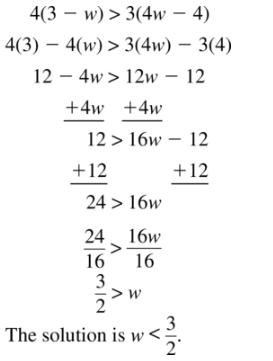
Evaluate the function for the given value of x.(Section 6.3)
Question 44.
f(x) – 4x; x = 3
Answer:
Question 45.
f(x) = 7x; x = -2
Answer:
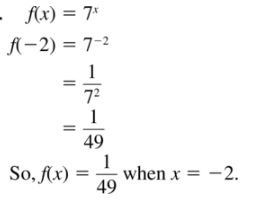
Question 46.
f(x) = 5(2)x; x = 6
Answer:
Question 47.
f(x) = -2(3)x; x = 4
Answer:

Lesson 11.2 Box-and-Whisker Plots
Essential Question How can you use a box-and-whisker plot to describe a data set?
EXPLORATION 1
Drawing a Box-and-Whisker Plot
Work with a partner. The numbers of first cousins of the students in a ninth-grade class are shown. A box-and-whisker plot is one way to represent the data visually.
a. Order the data on a strip of grid paper with 24 equally spaced boxes. Fold the paper in half to find the median.

b. Fold the paper in half again to divide the data into four groups. Because there are 24 numbers in the data set, each group should have 6 numbers. Find the least value, the greatest value, the first quartile, and the third quartile.

c. Explain how the box-and-whisker plot shown represents the data set.

Answer:
CommunicateYour Answer
Question 2.
How can you use a box-and-whisker plot to describe a data set?
Answer:
Question 3.
Interpret each box-and-whisker plot.
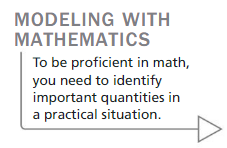
a. body mass indices (BMI) of students in a ninth-grade class

b. heights of roller coasters at an amusement park

Answer:
Monitoring Progress
Question 1.
A basketball player scores 14, 16, 20, 5, 22, 30, 16, and 28 points during a tournament. Make a box-and-whisker plot that represents the data.
Answer:
Use the box-and-whisker plot in Example 1.
Question 2.
Find and interpret the range and interquartile range of the data.
Answer:
Question 3.
Describe the distribution of the data.
Answer:
Question 4.
The double box-and-whisker plot represents the surfboard prices at Shop A and Shop B. Identify the shape of each distribution. Which shop’s prices are more spread out? Explain.

Answer:
Box-and-Whisker Plots 11.2 Exercises
Vocabulary and Core Concept Check
Question 1.
WRITING
Describe how to find the first quartile of a data set.
Answer:

Question 2.
DIFFERENT WORDS, SAME QUESTION
Consider the box-and-whisker plot shown. Which is different? Find “both” answers.

Answer:
Monitoring Progress and Modeling with Mathematics
In Exercises 3–8, use the box-and-whisker plot to find the given measure.

Question 3.
least value
Answer:
![]()
Question 4.
greatest value
Answer:
Question 5.
third quartile
Answer:
![]()
Question 6.
first quartile
Answer:
Question 7.
median
Answer:
![]()
Question 8.
range
Answer:
In Exercises 9–12, make a box-and-whisker plot that represents the data.
Question 9.
Hours of television watched: 0, 3, 4, 5, 2, 4, 6, 5
Answer:
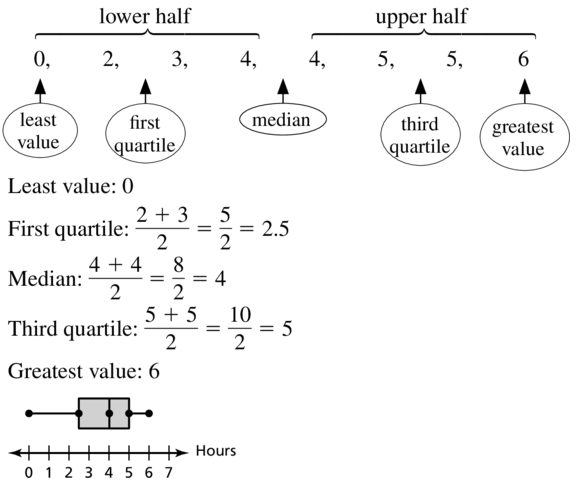
Question 10.
Cat lengths (in inches): 16, 18, 20, 25, 17, 22, 23, 21
Answer:
Question 11.
Elevations (in feet): -2, 0, 5, -4, 1, -3, 2, 0, 2, -3, 6
Answer:
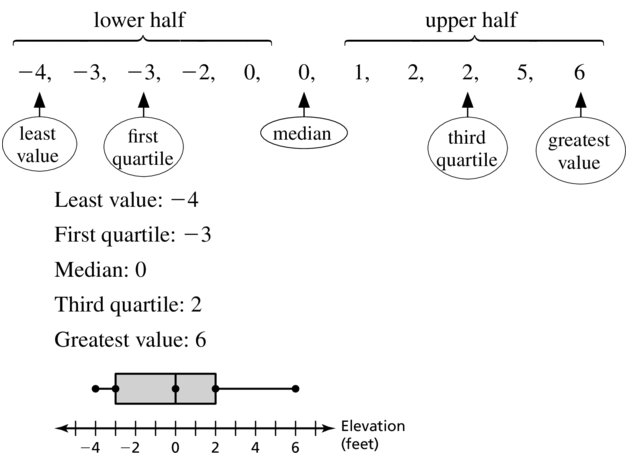
Question 12.
MP3 player prices (in dollars): 124, 95, 105, 110, 95, 124, 300, 190, 114
Answer:
Question 13.
ANALYZING DATA
The dot plot represents the numbers of hours students spent studying for an exam. Make a box-and-whisker plot that represents the data.

Answer:

Question 14.
ANALYZING DATA
The stem-and-leaf plot represents the lengths (in inches) of the fish caught on a fishing trip. Make a box-and-whisker plot that represents the data.
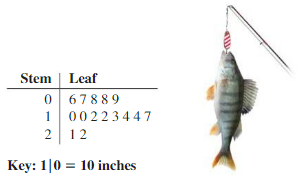
Answer:
Question 15.
ANALYZING DATA
The box-and-whisker plot represents the prices (in dollars) of the entrées at a restaurant.

a. Find and interpret the range of the data.
b. Describe the distribution of the data.
c. Find and interpret the interquartile range of the data.
d. Are the data more spread out below Q1 or above or Q3? Explain.
Answer:
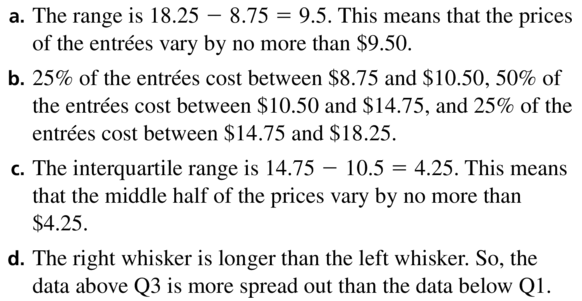
Question 16.
ANALYZING DATA
A baseball player scores 101 runs in a season. The box-and-whisker plot represents the numbers of runs the player scores against different opposing teams.

a. Find and interpret the range and interquartile range of the data.
b. Describe the distribution of the data. c. Are the data more spread out between Q1 and Q2 or between Q2 and Q3? Explain.
Answer:
Question 17.
ANALYZING DATA
The double box-and-whisker plot represents the monthly car sales for a year for two sales representatives.

a. Identify the shape of each distribution.
b. Which representative’s sales are more spread out? Explain.
c. Which representative had the single worst sales month during the year? Explain.
Answer:

Question 18.
ERROR ANALYSIS
Describe and correct the error in describing the box-and-whisker plot.

Answer:
Question 19.
WRITING
Given the numbers 36 and 12, identify which number is the range and which number is the interquartile range of a data set. Explain.
Answer:

Question 20.
HOW DO YOU SEE IT?
The box-and-whisker plot represents a data set. Determine whether each statement is always true. Explain your reasoning.

a. The data set contains the value 11.
b. The data set contains the value 6.
c. The distribution is skewed right.
d. The mean of the data is 5.
Answer:
Question 21.
ANALYZING DATA
The double box-and-whisker plot represents the battery lives (in hours) of two brands of cell phones.

a. Identify the shape of each distribution.
b. What is the range of the upper 75% of each brand?
c. Compare the interquartile ranges of the two data sets.
d. Which brand do you think has a greater standard deviation? Explain.
e. You need a cell phone that has a battery life of more than 3.5 hours most of the time. Which brand should you buy? Explain.
Answer:
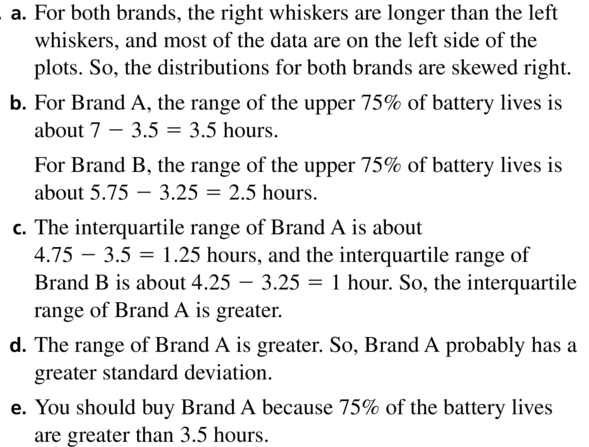
Question 22.
THOUGHT PROVOKING
Create a data set that can be represented by the box-and-whisker plot shown. Justify your answer.

Answer:
Question 23.
CRITICAL THINKING
Two data sets have the same median, the same interquartile range, and the same range. Is it possible for the box-and-whisker plots of the data sets to be different? Justify your answer.
Answer:
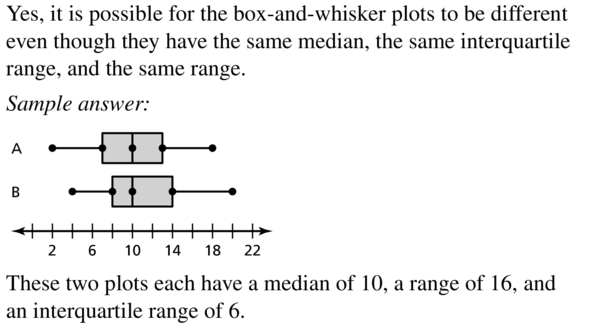
Maintaining Mathematical Proficiency
Use zeros to graph the function. (Section 8.5)
Question 24.
f(x) = -2(x + 9)(x – 3)
Answer:
Question 25.
y = 3(x – 5)(x + 5)
Answer:
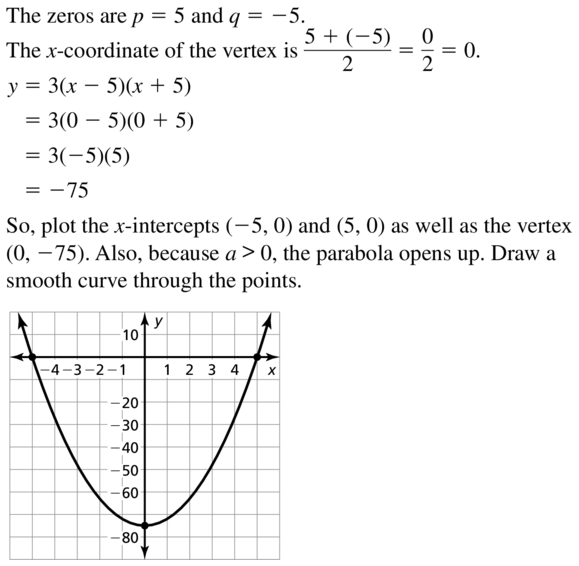
Question 26.
y = 4x2 – 16x = 48
Answer:
Question 27.
h(x) = -x2 + 5x + 14
Answer:


Lesson 11.3 Shapes of Distributions
Essential Question How can you use a histogram to characterize the basic shape of a distribution?
EXPLORATION 1
Analyzing a Famous Symmetric Distribution
Work with a partner. A famous data set was collected in Scotland in the mid-1800s. It contains the chest sizes, measured in inches, of 5738 men in the Scottish Militia. Estimate the percent of the chest sizes that lie within (a) 1 standard deviation of the mean, (b) 2 standard deviations of the mean, and (c) 3 standard deviations of the mean. Explain your reasoning.

Answer:
EXPLORATION 2
Comparing Two Symmetric Distributions
Work with a partner. The graphs show the distributions of the heights of 250 adult American males and 250 adult American females.

Answer:
a. Which data set has a smaller standard deviation? Explain what this means in the context of the problem.
b. Estimate the percent of male heights between 67 inches and 73 inches.
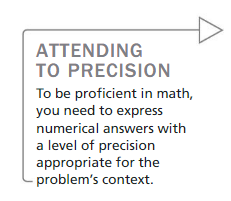
Answer:
CommunicateYour Answer
Question 3.
How can you use a histogram to characterize the basic shape of a distribution?
Answer:
Question 4.
All three distributions in Explorations 1 and 2 are roughly symmetric. The histograms are called “bell-shaped.”
a. What are the characteristics of a symmetric distribution?
b.Why is a symmetric distribution called “bell-shaped?”
c. Give two other real-life examples of symmetric distributions.Shapes of Distributions.
Answer:
Monitoring Progress
Question 1.
The frequency table shows the numbers of pounds of aluminum cans collected by classes for a fundraiser. Display the data in a histogram. Describe the shape of the distribution.
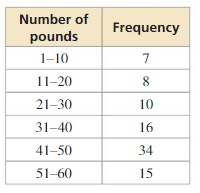
Answer:
Question 2.
You record the numbers of email attachments sent by 30 employees of a company in 1 week. Your results are shown in the table. (a) Display the data in a histogram using six intervals beginning with 1–20. (b) Which measures of center and variation best represent the data? Explain.
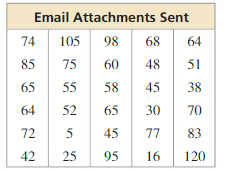
Answer:
Question 3.
Compare the distributions using their shapes and appropriate measures of center and variation.
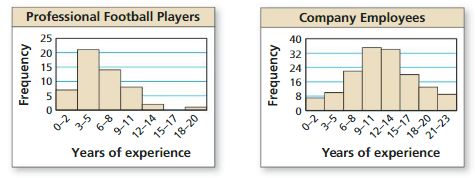
Answer:
Question 4.
Why is the mean greater than the median for the men?
Answer:
Question 5.
If 50 more women are surveyed, about how many more would you expect to own between 10 and 18 pairs of shoes?
Answer:
Shapes of Distributions 11.3 Exercises
Vocabulary and Core Concept Check
Question 1.
VOCABULARY
Describe how data are distributed in a symmetric distribution, a distribution that is skewed left, and a distribution that is skewed right.
Answer:

Question 2.
WRITING
How does the shape of a distribution help you decide which measures of center and variation best describe the data?
Answer:
Monitoring Progress and Modeling with Mathematics
Question 3.
DESCRIBING DISTRIBUTIONS
The frequency table shows the numbers of hours that students volunteer per month. Display the data in a histogram. Describe the shape of the distribution.

Answer:

Question 4.
DESCRIBING DISTRIBUTIONS
The frequency table shows the results of a survey that asked people how many hours they spend online per week. Display the data in a histogram. Describe the shape of the distribution.
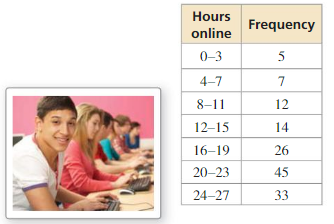
Answer:
In Exercises 5 and 6, describe the shape of the distribution of the data. Explain your reasoning.
Question 5.
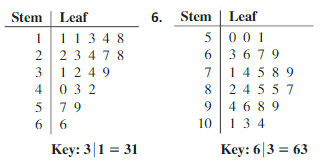
Answer:

In Exercises 7 and 8, determine which measures of center and variation best represent the data. Explain your reasoning.
Question 7.
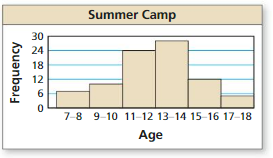
Answer:

Question 8.

Answer:
Question 9.
ANALYZING DATA
The table shows the last 24 ATM withdrawals at a bank.

a. Display the data in a histogram using seven intervals beginning with 26–50.
b. Which measures of center and variation best represent the data? Explain.
c. The bank charges a fee for any ATM withdrawal less than $150. How would you interpret the data?
Answer:


Question 10.
ANALYZING DATA
Measuring an IQ is an inexact science. However, IQ scores have been around for years in an attempt to measure human intelligence. The table shows some of the greatest known IQ scores.

a. Display the data in a histogram using five intervals beginning with 151–166.
b. Which measures of center and variation best represent the data? Explain.
c. The distribution of IQ scores for the human population is symmetric. What happens to the shape of the distribution in part (a) as you include more and more IQ scores from the human population in the data set?
Answer:
ERROR ANALYSIS In Exercises 11 and 12, describe and correct the error in the statements about the data displayed in the histogram.
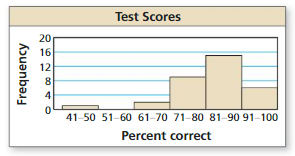
Question 11.

Answer:

Question 12.

Answer:
Question 13.
USING TOOLS
For a large data set, would you use a stem-and-leaf plot or a histogram to show the distribution of the data? Explain.
Answer:

Question 14.
REASONING
For a symmetric distribution, why is the mean used to describe the center and the standard deviation used to describe the variation? For a skewed distribution, why is the median used to describe the center and the ve-number summary used to describe the variation?
Answer:
Question 15.
COMPARING DATA SETS
The double histogram shows the distributions of daily high temperatures for two towns over a 50-day period. Compare the distributions using their shapes and appropriate measures of center and variation.
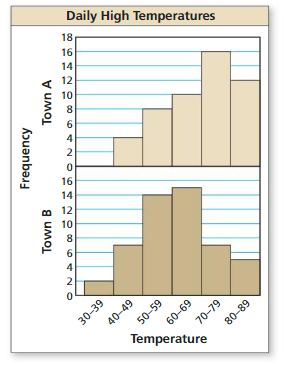
Answer:

Question 16.
COMPARING DATA SETS
The frequency tables show the numbers of entrées in certain price ranges (in dollars) at two different restaurants. Display the data in a double histogram. Compare the distributions using their shapes and appropriate measures of center and variation.
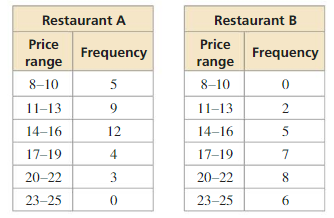
Answer:
Question 17.
OPEN-ENDED
Describe a real-life data set that has a distribution that is skewed right.
Answer:

Question 18.
OPEN-ENDED
Describe a real-life data set that has a distribution that is skewed left.
Answer:
Question 19.
COMPARING DATA SETS
The table shows the results of a survey that asked freshmen and sophomores how many songs they have downloaded on their MP3 players.

a. Make a double box-and-whisker plot that represents the data. Describe the shape of each distribution.
b. Compare the number of songs downloaded by freshmen to the number of songs downloaded by sophomores.
c. About how many of the freshmen surveyed would you expect to have between 730 and 1570 songs downloaded on their MP3 players?
d. If you survey100 more freshmen, about how many would you expect to have downloaded between 310 and 1990 songs on their MP3 players?
Answer:
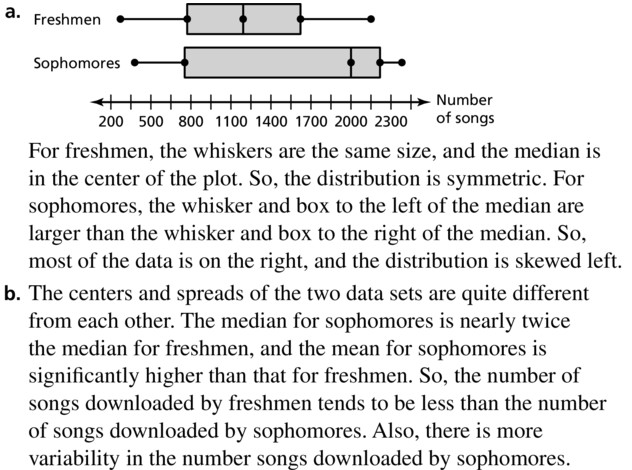
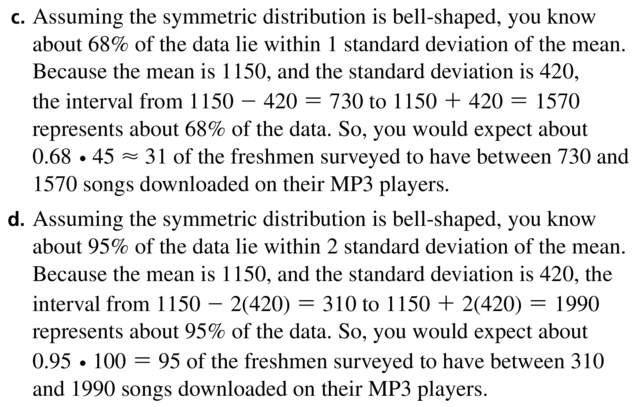
Question 20.
COMPARING DATA SETS
You conduct the same survey as in Exercise 19 but use a different group of freshmen. The results are as follows.Survey size: 60; minimum: 200; maximum: 2400; 1st quartile: 640; median: 1670; 3rd quartile: 2150; mean: 1480; standard deviation: 500
a. Compare the number of songs downloaded by this group of freshmen to the number of songs downloaded by sophomores.
b. Why is the median greater than the mean for this group of freshmen?
Answer:
Question 21.
REASONING
A data set has a symmetric distribution. Every value in the data set is doubled. Describe the shape of the new distribution. Are the measures of center and variation affected? Explain.
Answer:

Question 22.
HOW DO YOU SEE IT?
Match the distribution with the corresponding box-and-whisker plot.
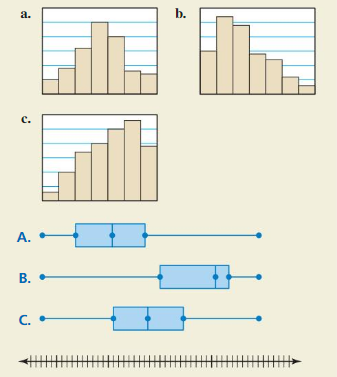
Answer:
Question 23.
REASONING
You record the following waiting times at a restaurant.

a. Display the data in a histogram using five intervals beginning with 0–9. Describe the shape of the distribution.
b. Display the data in a histogram using 10 intervals beginning with 0–4. What happens when the number of intervals is increased?
c. Which histogram best represents the data? Explain your reasoning.
Answer:

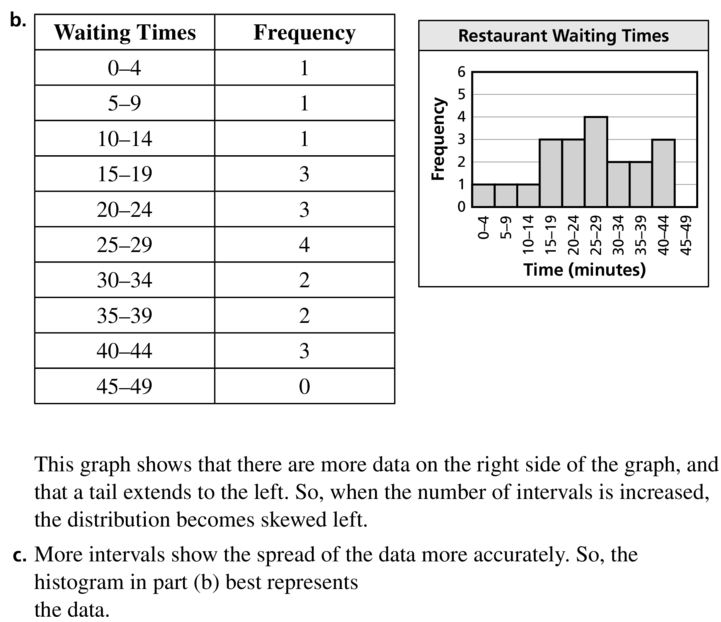
Question 24.
THOUGHT PROVOKING
The shape of a bimodal distribution is shown. Describe a real-life example of a bimodal distribution.
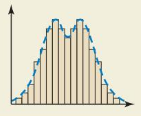
Answer:
Maintaining Mathematical Proficiency
Find the domain of the function.(Section 10.1)
Question 25.
f(x) = \(\sqrt{x+6}\)
Answer:
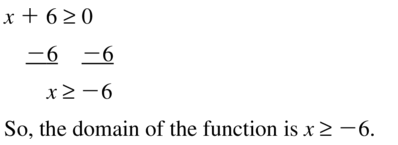
Question 26.
f(x) = \(\sqrt{2x}\)
Answer:
Question 27.
f(x) = \(\frac{1}{4} \sqrt{x-7}\)
Answer:

Data Analysis and Displays Study Skills: Studying for Finals
11.1–11.3What Did YouLearn?
Core Vocabulary

Core Concepts

Mathematical Practices
Question 1.
Exercises 15 and 16 on page 590 are similar. For each data set, is the outlier much greater than or much less than the rest of the data values? Compare how the outliers affect the means. Explain why this makes sense.
Answer:
Question 2.
In Exercise 18 on page 605, provide a possible reason for why the distribution is skewed left.
Answer:

Data Analysis and Displays 1.1–11.3 Quiz
Find the mean, median, and mode of the data set. Which measure of center best represents the data? Explain.(Section 11.1)
Question 1.
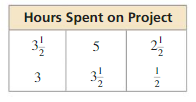
Answer:
Question 2.

Answer:
Find the range and standard deviation of each data set. Then compare your results.(Section 11.1)
Question 3.
Absent students during a week of school
Female: 6, 2, 4, 3, 4
Male: 5, 3, 6, 6, 9
Answer:
Question 4.
Numbers of points scored
Juniors: 19, 15, 20, 10, 14, 21, 18, 15
Seniors: 22, 19, 29, 32, 15, 26, 30, 19
Answer:
Make a box-and-whisker plot that represents the data.(Section 11.2)
Question 5.
Ages of family members:
60, 15, 25, 20, 55, 70, 40, 30
Answer:
Question 6.
Minutes of violin practice:
20, 50, 60, 40, 40, 30, 60, 40, 50, 20, 20, 35
Answer:
Question 7.
Display the data in a histogram. Describe the shape of the distribution. (Section 11.3)

Question 8.
The table shows the prices of eight mountain bikes in a sporting goods store. (Section 11.1 and Section 11.2)
![]()
a. Find the mean, median, mode, range, and standard deviation of the prices.
b. Identify the outlier. How does the outlier affect the mean, median, and mode?
c. Make a box-and-whisker plot that represents the data. Find and interpret the interquartile range of the data. Identify the shape of the distribution.
d. Find the mean, median, mode, range, and standard deviation of the prices when the store offers a 5% discount on all mountain bikes.
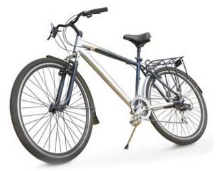
Answer:
Question 9.
The table shows the times of 20 presentations. (Section 11.3)
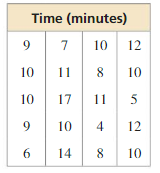
a. Display the data in a histogram using five intervals beginning with 3–5.
b. Which measures of center and variation best represent the data? Explain.
c. The presentations are supposed to be 10 minutes long. How would you interpret these results?
Answer:
Lesson 11.4 Two-Way Tables
Essential Question How can you read and make a two-way table?
EXPLORATION 1
Reading a Two-Way Table
Work with a partner. You are the manager of a sports shop. The two-way tables show the numbers of soccer T-shirts in stock at your shop at the beginning and end of the selling season. (a) Complete the totals for the rows and columns in each table. (b) How would you alter the number of T-shirts you order for next season? Explain your reasoning.
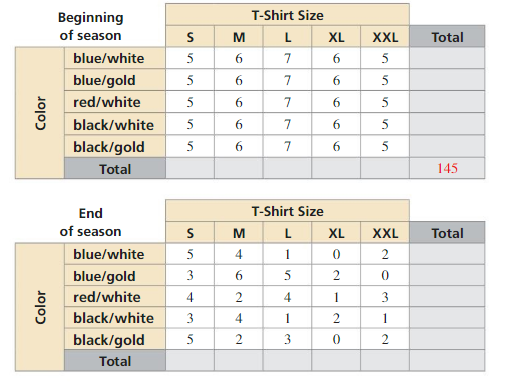
Answer:
EXPLORATION 2
Making a Two-Way Table
Work with a partner. The three-dimensional bar graph shows the numbers of hours students work at part-time jobs.
a. Make a two-way table showing the data. Use estimation to find the entries in your table.
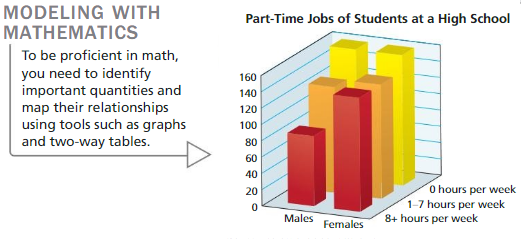
b. Write two observations that summarize the data in your table.
Answer:
Communicate Your Answer
Question 3.
How can you read and make a two-way table?
Answer:
Monitoring Progress
Question 1.
You conduct a technology survey to publish on your school’s website. You survey students in the school cafeteria about the technological devices they own. The results are shown in the two-way table. Find and interpret the marginal frequencies.
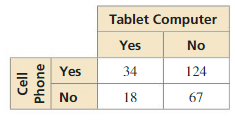
Answer:
Question 2.
You survey students about whether they are getting a summer job. Seventy-five males respond, with 18 of them responding “no.” Fifty-seven females respond, with 45 of them responding “yes.” Organize the results in a two-way table. Include the marginal frequencies.
Answer:
Question 3.
Use the survey results in Monitoring Progress Question 2 to make a two-way table that shows the joint and marginal relative frequencies. What percent of students are not getting a summer job?
Answer:
Question 4.
Use the survey results in Example 3 to make a two-way table that shows the conditional relative frequencies based on the row totals. Given that a student is a senior, what is the conditional relative frequency that he or she is planning to major in a medical field?
Answer:
Question 5.
Using the results of the survey in Monitoring Progress Question 1, is there an association between owning a tablet computer and owning a cell phone? Explain your reasoning.
Answer:
Two-Way Tables 11.4 Exercises
Vocabulary and Core Concept Check
Question 1.
COMPLETE THE SENTENCE
Each entry in a two-way table is called a(n) __________.
Answer:
![]()
Question 2.
WRITING
When is it appropriate to use a two-way table to organize data?
Answer:
Question 3.
VOCABULARY
Explain the relationship between joint relative frequencies, marginal relative frequencies, and conditional relative frequencies.
Answer:

Question 4.
WRITING
Describe two ways you can find conditional relative frequencies.
Answer:
Monitoring Progress and Modeling with Mathematics
You conduct a survey that asks 346 students whether they buy lunch at school. In Exercises 5–8, use the results of the survey shown in the two-way table.
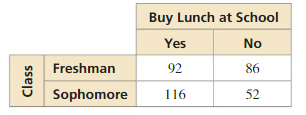
Question 5.
How many freshmen were surveyed?
Answer:
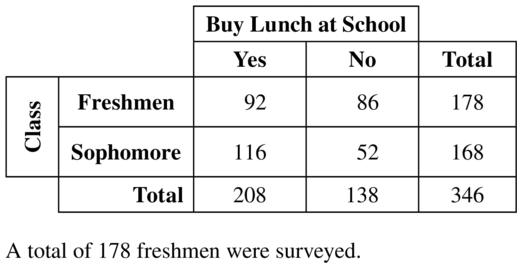
Question 6.
How many sophomores were surveyed?
Answer:
Question 7.
How many students buy lunch at school?
Answer:
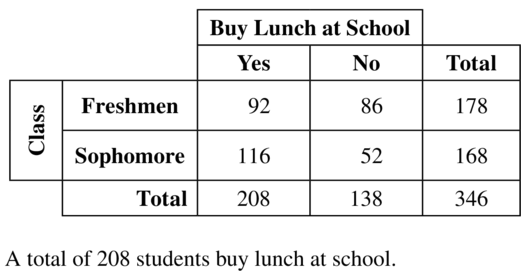
Question 8.
How many students do not buy lunch at school?
Answer:
In Exercises 9 and 10, find and interpret the marginal frequencies.
Question 9.
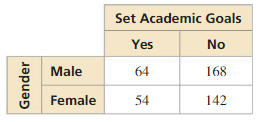
Answer:
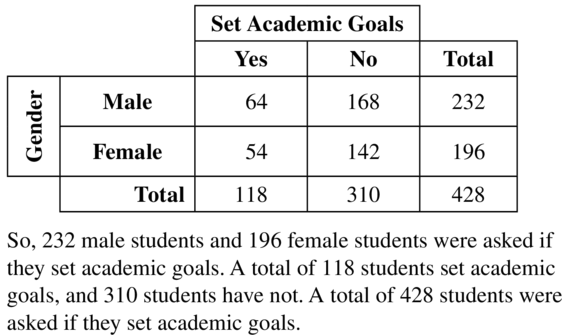
Question 10.

Answer:
Question 11.
USING TWO-WAY TABLES
You conduct a survey that asks students whether they plan to participate in school spirit week. The results are shown in the two-way table. Find and interpret the marginal frequencies.
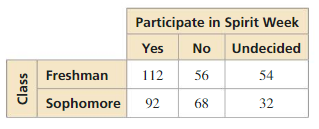
Answer:

Question 12.
USING TWO-WAY TABLES
You conduct a survey that asks college-bound high school seniors about the type of degree they plan to receive. The results are shown in the two-way table. Find and interpret the marginal frequencies.
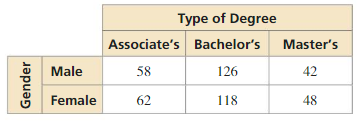
Answer:
USING STRUCTURE In Exercises 13 and 14, complete the two-way table..
Question 13.
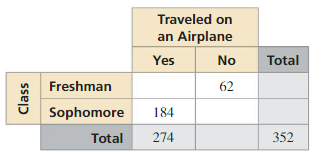
Answer:
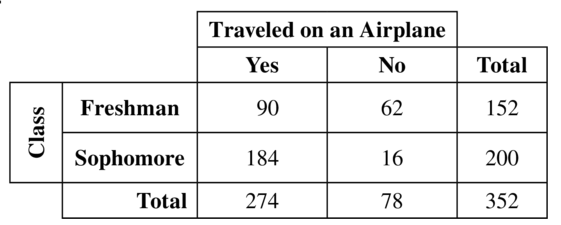
Question 14.
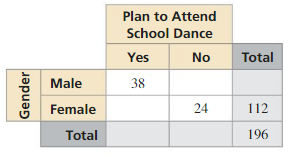
Answer:
Question 15.
MAKING TWO-WAY TABLES
You conduct a survey that asks 245 students in your school whether they have taken a Spanish or a French class. One hundred nine of the students have taken a Spanish class, and 45 of those students have taken a French class. Eighty-two of the students have not taken a Spanish or a French class. Organize the results in a two-way table. Include the marginal frequencies.
Answer:
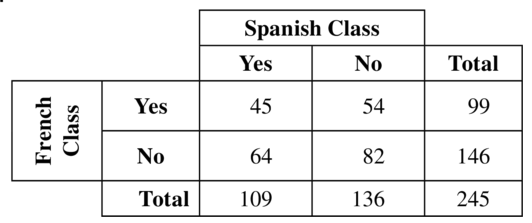
Question 16.
MAKING TWO-WAY TABLES
A car dealership has 98 cars on its lot. Fifty-five of the cars are new. Of the new cars, 36 are domestic cars. There are 15 used foreign cars on the lot. Organize this information in a two-way table. Include the marginal frequencies. In Exercises 17 and 18, make a two-way table that shows the joint and marginal relative frequencies.

Answer:
In Exercises 17 and 18, make a two-way table that shows the joint and marginal relative frequencies.
Question 17.
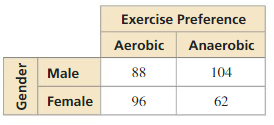
Answer:
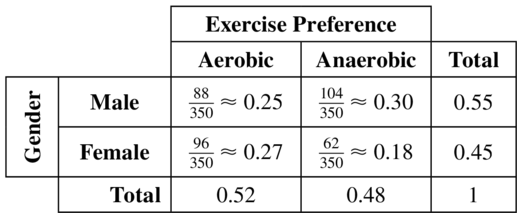
Question 18.
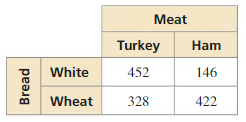
Answer:
Question 19.
USING TWO-WAY TABLES
Refer to Exercise 17. What percent of students prefer aerobic exercise? What percent of students are males who prefer anaerobic exercise?
Answer:

Question 20.
USING TWO-WAY TABLES
Refer to Exercise 18. What percent of the sandwiches are on wheat bread? What percent of the sandwiches are turkey on white bread?
Answer:
ERROR ANALYSIS In Exercises 21 and 22, describe and correct the error in using the two-way table.
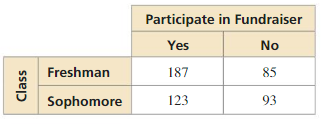
Question 21.

Answer:

Question 22.

Answer:
Question 23.
USING TWO-WAY TABLES
A company is hosting an event for its employees to celebrate the end of the year. It asks the employees whether they prefer a lunch event or a dinner event. It also asks whether they prefer a catered event or a potluck. The results are shown in the two-way table. Make a two-way table that shows the conditional relative frequencies based on the row totals. Given that an employee prefers a lunch event, what is the conditional relative frequency that he or she prefers a catered event?
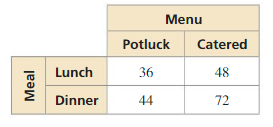
Answer:
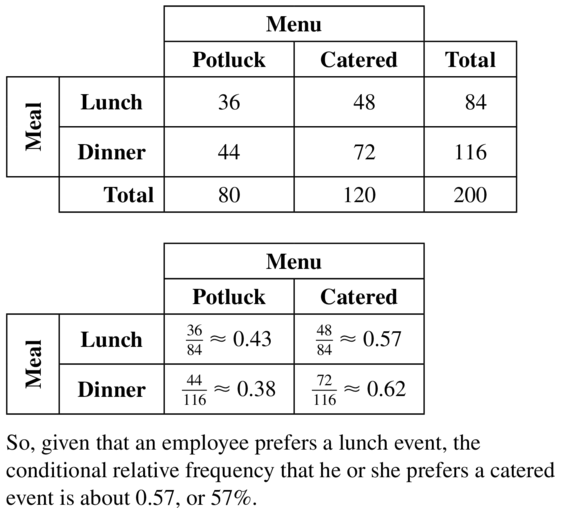
Question 24.
USING TWO-WAY TABLES
The two-way table shows the results of a survey that asked students about their preference for a new school mascot. Make a two-way table that shows the conditional relative frequencies based on the column totals. Given that a student prefers a hawk as a mascot, what is the conditional relative frequency that he or she prefers a cartoon mascot?
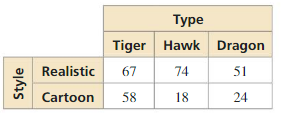
Answer:
Question 25.
ANALYZING TWO-WAYTABLES
You survey college-bound seniors and find that 85% plan to live on campus, 35% plan to have a car while at college, and 5% plan to live off campus and not have a car. Is there an association between living on campus and having a car at college? Explain.
Answer:
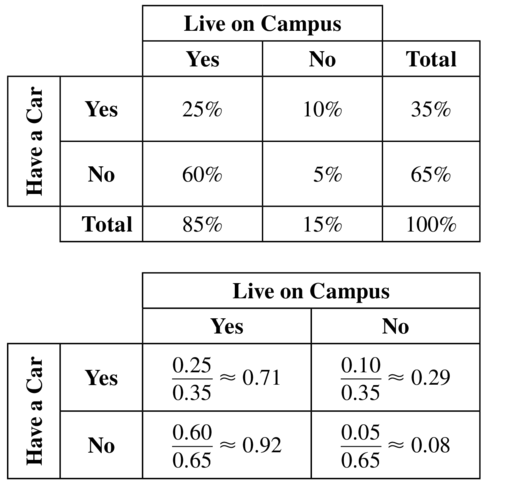

Question 26.
ANALYZING TWO-WAYTABLES
You survey students and find that 70% watch sports on TV, 48% participate in a sport, and 16% do not watch sports on TV or participate in a sport. Is there an association between participating in a sport and watching sports on TV? Explain.

Answer:
Question 27.
ANALYZING TWO-WAY TABLES
The two-way table shows the results of a survey that asked adults whether they participate in recreational skiing. Is there an association between age and recreational skiing?

Answer:
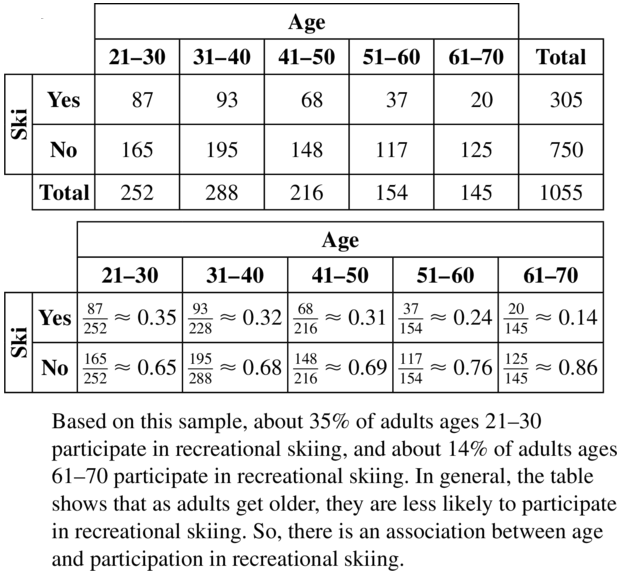
Question 28.
ANALYZING TWO-WAY TABLES
Refer to Exercise 12. Is there an association between gender and type of degree? Explain.
Answer:
Question 29.
WRITING
Compare Venn diagrams and two-way tables.
Answer:

Question 30.
HOW DO YOU SEE IT?
The graph shows the results of a survey that asked students about their favorite movie genre.
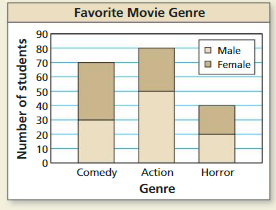
a. Display the given information in a two-way table.
b. Which of the data displays do you prefer? Explain.
Answer:
Question 31.
PROBLEM SOLVING
A box office sells 1809 tickets to a play, 800 of which are for the main floor. The tickets consist of 2x + y adult tickets on the main floor, x – 40 child tickets on the main floor, x + 2y adult tickets in the balcony, and 3x – y – 80 child tickets in the balcony.
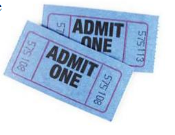
a. Organize this information in a two-way table.
b. Find the values of x and y.
c. What percent of tickets are adult tickets?
d. What percent of child tickets are balcony tickets?
Answer:


Question 32.
THOUGHT PROVOKING
Compare “one-way tables” and “two-way tables.” Is it possible to have a “three-way table?” If so, give an example of a three-way table.
Answer:
Maintaining Mathematical Proficiency
Tell whether the table of values represents a linear, an exponential, or a quadratic function. (Section 8.6)
Question 33.

Answer:
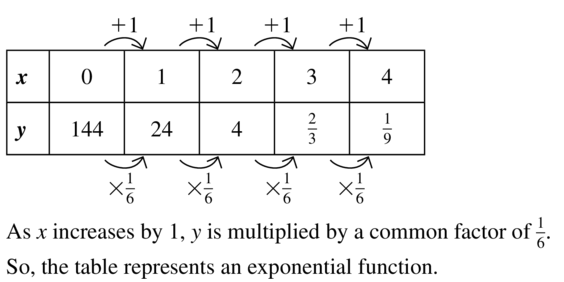
Question 34.

Answer:
Lesson 11.5 Choosing a Data Display
Essential Question How can you display data in a way that helps you make decisions?
EXPLORATION 1
Displaying Data
Work with a partner. Analyze the data and then create a display that best represents the data. Explain your choice of data display.
a. A group of schools in New England participated in a 2-month study and reported 3962 animals found dead along roads.
birds: 307
mammals: 2746
amphibiAnswer: 145
reptiles: 75
unknown: 689
b. The data below show the numbers of black bears killed on a state’s roads from 1993 to 2012.
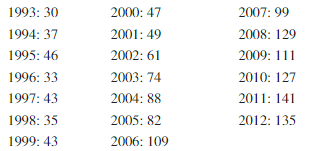
c. A 1-week study along a 4-mile section of road found the following weights (in pounds) of raccoons that had been killed by vehicles.

d. A yearlong study by volunteers in California reported the following numbers of animals killed by motor vehicles.

Answer:
Communicate Your Answer
Question 2.
How can you display data in a way that helps you make decisions?
Answer:
Question 3.
Use the Internet or some other reference to find examples of the following types of data displays.

bar graph
circle graph
scatter plot
stem-and-leaf plot
pictograph
line graph
box-and-whisker plot
histogram
dot plot
Monitoring Progress
Tell whether the data are qualitative or quantitative. Explain your reasoning.
Question 1.
telephone numbers in a directory
Answer:
Question 2.
ages of patients at a hospital
Answer:
Question 3.
lengths of videos on a website
Answer:
Question 4.
types of flowers at a florist
Answer:
Question 5.
Display the data in Example 2(a) in another way.
Answer:
Question 6.
Display the data in Example 2(b) in another way.
Answer:
Question 7.
Redraw the graphs in Example 3 so they are not misleading.
Answer:
Choosing a Data Display 11.5 Exercises
Vocabulary and Core Concept Check
Question 1.
OPEN-ENDED
Describe two ways that a line graph can be misleading.
Answer:

Question 2.
WHICH ONE DOESN’T BELONG?
Which data set does not belong with the other three? Explain your reasoning.

Answer:
Monitoring Progress and Modeling with Mathematics
In Exercises 3–8, tell whether the data are qualitative or quantitative. Explain your reasoning.
Question 3.
brands of cars in a parking lot
Answer:

Question 4.
weights of bears at a zoo
Answer:
Question 5.
budgets of feature films
Answer:

Question 6.
file formats of documents on a computer
Answer:
Question 7.
shoe sizes of students in your class
Answer:

Question 8.
street addresses in a phone book
Answer:
In Exercises 9–12, choose an appropriate data display for the situation. Explain your reasoning.
Question 9.
the number of students in a marching band each year
Answer:

Question 10.
a comparison of students’ grades (out of 100) in two different classes
Answer:
Question 11.
the favorite sports of students in your class
Answer:

Question 12.
the distribution of teachers by age
Answer:
In Exercises 13–16, analyze the data and then create a display that best represents the data. Explain your reasoning.
Question 13.

Answer:
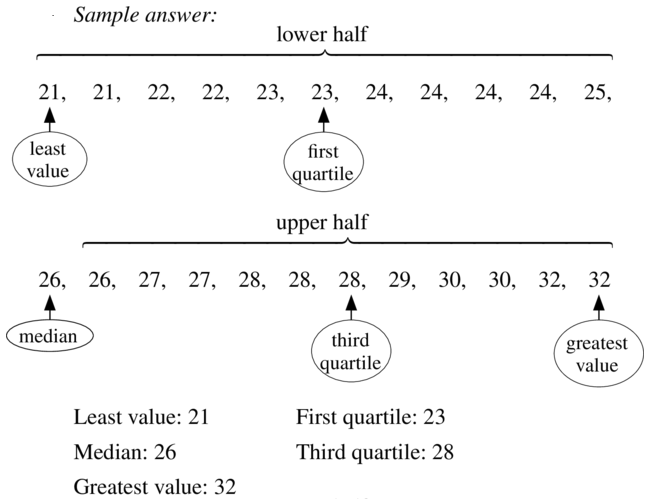

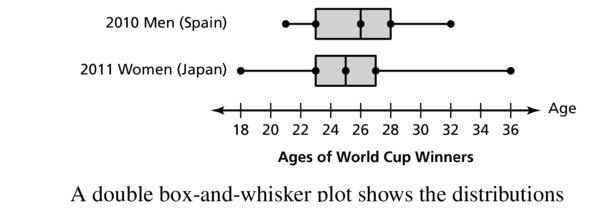
Question 14.
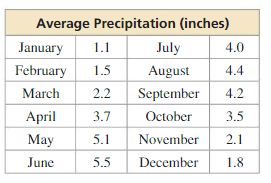
Answer:
Question 15.

Answer:

Question 16.

Answer:
Question 17.
DISPLAYING DATA
Display the data in Exercise 13 in another way.
Answer:
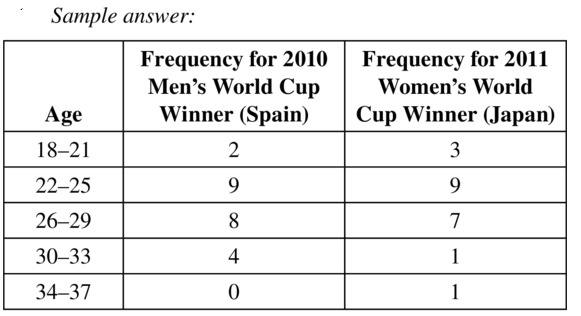
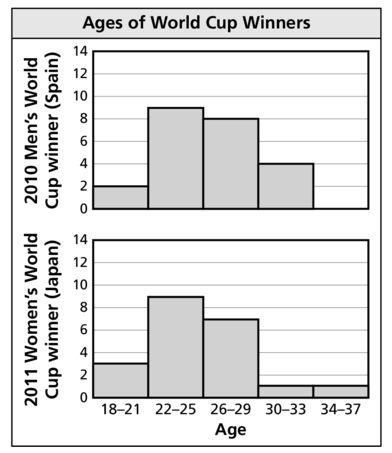
Question 18.
DISPLAYING DATA
Display the data in Exercise 14 in another way.
Answer:
Question 19.
DISPLAYING DATA
Display the data in Exercise 15 in another way.
Answer:

Question 20.
DISPLAYING DATA
Display the data in Exercise 16 in another way.
Answer:
In Exercises 21–24, describe how the graph is misleading. Then explain how someone might misinterpret the graph.
Question 21.
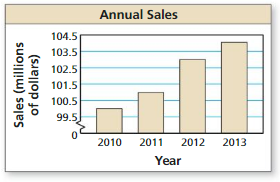
Answer:

Question 22.

Answer:
Question 23.

Answer:

Question 24.
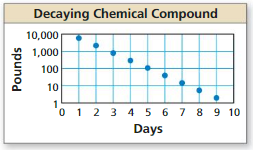
Answer:
Question 25.
DISPLAYING DATA
Redraw the graph in Exercise 21 so it is not misleading.
Answer:

Question 26.
DISPLAYING DATA
Redraw the graph in Exercise 22 so it is not misleading.
Answer:
Question 27.
MAKING AN ARGUMENT
A data set gives the ages of voters for a city election. Classmate A says the data should be displayed in a bar graph, while Classmate B says the data would be better displayed in a histogram. Who is correct? Explain.
Answer:

Question 28.
HOW DO YOU SEE IT?
The manager of a company sees the graph shown and concludes that the company is experiencing a decline. What is missing from the graph? Explain why the manager may be mistaken.
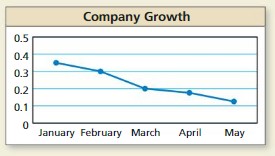
Answer:
Question 29.
REASONING
A survey asked 100 students about the sports they play. The results are shown in the circle graph.
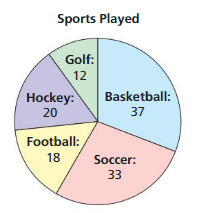
a. Explain why the graph is misleading.
b. What type of data display would be more appropriate for the data? Explain.
Answer:

Question 30.
THOUGHT PROVOKING
Use a spreadsheet program to create a type of data display that is not used in this section.
Answer:
Question 31.
REASONING
What type of data display shows the mode of a data set?
Answer:

Maintaining Mathematical Proficiency
Determine whether the relation is a function. Explain.(Section 3.1)
Question 32.
(-5, -1), (-6, 0), (-5, 1), (-2, 2), (3 , 3)
Answer:
Question 33.
(0, 1), (4, 0), (8, 1), (12, 2), (16, 3)
Answer:

Data Analysis and Displays Performance Task: College Students Study Time
11.4–11.5 What Did You Learn?
Core Vocabulary

Core Concepts

Mathematical Practices
Question 1.
Consider the data given in the two-way table for Exercises 5–8 on page 614. Your sophomore friend responded to the survey. Is your friend more likely to have responded “yes” or “no” to buying a lunch? Explain.
Answer:
Question 2.
Use your answer to Exercise 28 on page 622 to explain why it is important for a company manager to see accurate graphs.
Answer:
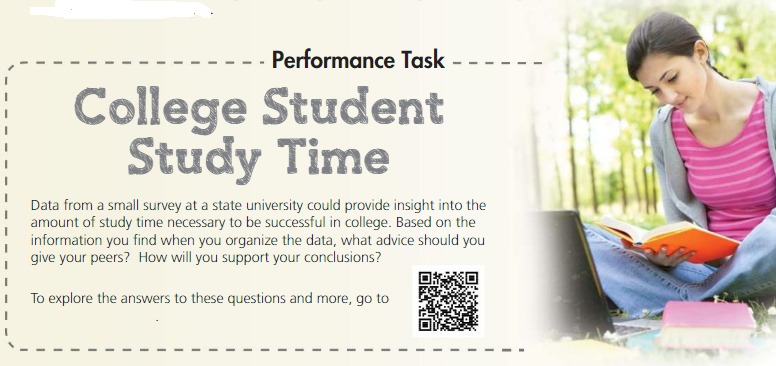
Data Analysis and Displays Chapter Review
11.1 Measures of Center and Variation (pp. 585–592)
Question 1.
Use the data in the example above. You run 4.0 miles on Day 11. How does this additional value affect the mean, median, and mode? Explain.
Answer:
Question 2.
Use the data in the example above. You run 10.0 miles on Day 11. How does this additional value affect the mean, median, and mode? Explain.
Answer:
Find the mean, median, and mode of the data.
Question 3.
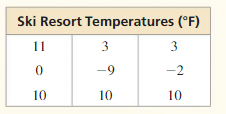
Answer:
Question 4.

Answer:
Find the range and standard deviation of each data set. Then compare your results.
Question 5.

Answer:
Question 6.
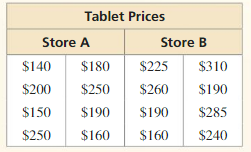
Answer:
Find the values of the measures shown after the given transformation.
Mean: 109 Median: 104 Mode: 96 Range: 45 Standard deviation: 3.6
Question 7.
Each value in the data set increases by 25.
Answer:
Question 8.
Each value in the data set is multiplied by 0.6
Answer:
11.2 Box-and-Whisker Plots (pp. 593–598)
Make a box-and-whisker plot that represents the data. Identify the shape of the distribution.
Question 9.
Ages of volunteers at a hospital:
14, 17, 20, 16, 17, 14, 21, 18, 22
Answer:
Question 10.
Masses (in kilograms) of lions:
120, 230, 180, 210, 200, 200, 230, 160
Answer:
11.3 Shapes of Distributions (pp. 599–606)
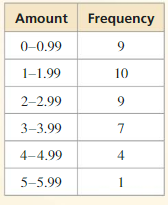
Question 11.
The frequency table shows the amounts (in dollars) of money the students in a class have in their pockets.
a. Display the data in a histogram. Describe the shape of the distribution.
b. Which measures of center and variation best represent the data?
c. Compare this distribution with the distribution shown above using their shapes and appropriate measures of center and variation.
Answer:
11.4 Two-Way Tables (pp. 609–616)
Question 12.
The two-way table shows the results of a survey that asked shoppers at a mall about whether they like the new food court.
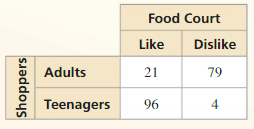
a. Make a two-way table that shows the joint and marginal relative frequencies.
b. Make a two-way table that shows the conditional relative frequencies based on the column totals.
Answer:
11.5 Choosing a Data Display (pp. 617–622)
Question 13.
Analyze the data in the table at the right and then create a display that best represents the data. Explain your reasoning.
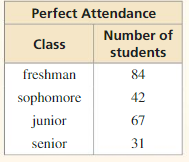
Answer:
Tell whether the data are qualitative or quantitative. Explain.
Question 14.
heights of the members of a basketball team
Answer:
Question 15.
grade level of students in an elementary school
Answer:
Data Analysis and Displays Chapter Test
Describe the shape of the data distribution. Then determine which measures of center and variation best represent the data.
Question 1.

Answer:
Question 2.

Answer:
Question 3.
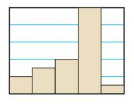
Answer:
Determine whether each statement is always, sometimes, or never true. Explain your reasoning.
a. The sum of the marginal relative frequencies in the “total” row and the “total” column of a two-way table should each be equal to 1.
b. In a box-and-whisker plot, the length of the box to the left of the median and the length of the box to the right of the median are equal.
c. Qualitative data are numerical.
Answer:
Question 5.
Find the mean, median, mode, range, and standard deviation of the prices.

Answer:
Question 6.
Repeat Exercise 5 when all the shirts in the clothing store are 20% off.
Answer:
Question 7.
Which data display best represents the data, a histogram or a stem-and-leaf plot? Explain.
15, 21, 18, 10, 12, 11, 17, 18, 16, 12, 20, 12, 17, 16
Answer:
Question 8.
The tables show the battery lives (in hours) of two brands of laptops.

a. Make a double box-and-whisker plot that represents the data.
b. Identify the shape of each distribution.
c. Which brand’s battery lives are more spread out? Explain.
d. Compare the distributions using their shapes and appropriate measures of center and variation.
Answer:
Question 9.
The table shows the results of a survey that asked students their preferred method of exercise. Analyze the data and then create a display that best represents the data. Explain your reasoning.

Answer:
Question 10.
You conduct a survey that asks 271 students in your class whether they are attending the class field trip. One hundred twenty-one males respond 92 of which are attending the field trip. Thirty-one females are not attending the field trip.
a. Organize the results in a two-way table. Find and interpret the marginal frequencies.
b. What percent of females are attending the class field trip?
Answer:
Data Analysis and Displays Cumulative Assessment
Question 1.
You ask all the students in your grade whether they have a cell phone. The results are shown in the two-way table. Your friend claims that a greater percent of males in your grade have cell phones than females. Do you support your friend’s claim? Justify your answer.
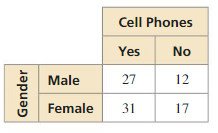
Answer:
Question 2.
Use the graphs of the functions to answer each question.
a. Are there any values of x greater than 0 where f (x) > h(x)? Explain.
b. Are there any values of x greater than 1 where g(x) > f(x)? Explain.
c. Are there any values of x greater than 0 where g(x) > h(x)? Explain.
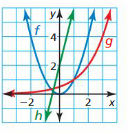
Answer:
Question 3.
Classify the shape of each distribution as symmetric, skewed left, or skewed right.
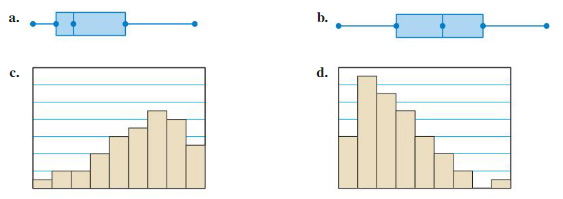
Answer:
Question 4.
Complete the equation so that the solutions of the system of equations are (-2, 4) and (1, -5).

Answer:
Question 5.
Pair each function with its inverse.

Answer:
Question 6.
The box-and-whisker plot represents the lengths (in minutes) of project presentations at a science fair. Find the interquartile range of the data. What does this represent in the context of the situation?

A. 7; The middle half of the presentation lengths vary by no more than 7 minutes.
B. 3; The presentation lengths vary by no more than 3 minutes.
C. 3; The middle half of the presentation lengths vary by no more than 3 minutes.
D. 7; The presentation lengths vary by no more than 7 minutes.
Answer:
Question 7.
Scores in a video game can be between 0 and 100. Use the data set shown to fill in a value for x so that each statement is true.
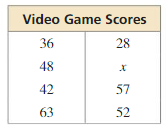
a. When x = ____, the mean of the scores is 45.5.
b. When x = ____, the median of the scores is 47.
c. When x = ____, the mode of the scores is 63.
d. When x = ____, the range of the scores is 71.
Answer:
Question 8.
Select all the numbers that are in the range of the function shown.

Answer:
Question 9.
A traveler walks and takes a shuttle bus to get to a terminal of an airport. The function y = D(x) represents the traveler’s distance (in feet) after x minutes.
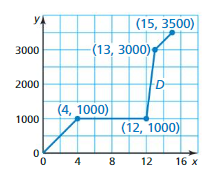
a. Estimate and interpret D(2).
b. Use the graph to find the solution of the equation D(x) = 3500. Explain the meaning of the solution.
c. How long does the traveler wait for the shuttle bus?
d. How far does the traveler ride on the shuttle bus?
e. What is the total distance that the traveler walks before and after riding the shuttle bus?
Answer:
